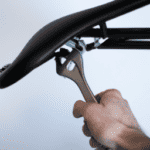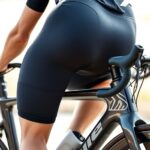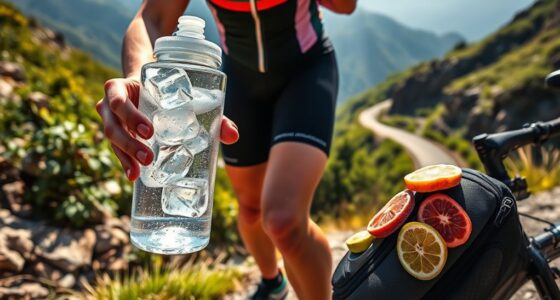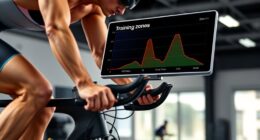A proper bike fit guarantees your saddle height and handlebar reach are customized to your body, boosting comfort, power, and performance. Adjusting your saddle so your knee bends slightly at the bottom of the pedal stroke helps prevent knee strain and improves efficiency. Proper handlebar reach keeps your posture relaxed and reduces fatigue. Small tweaks can make a big difference in riding experience and injury prevention—continue exploring these fundamentals to optimize your ride.
Key Takeaways
- Proper bike fit improves comfort, efficiency, and power transfer while reducing injury risk.
- Saddle height should allow a slight knee bend (~25-35°) at pedal bottom for optimal pedaling mechanics.
- Adjust handlebar reach to ensure elbows are slightly bent and the rider maintains a comfortable, balanced posture.
- Small adjustments in saddle height and handlebar position significantly enhance riding comfort and performance.
- A customized fit considers individual body dimensions and riding style for prolonged, comfortable cycling.
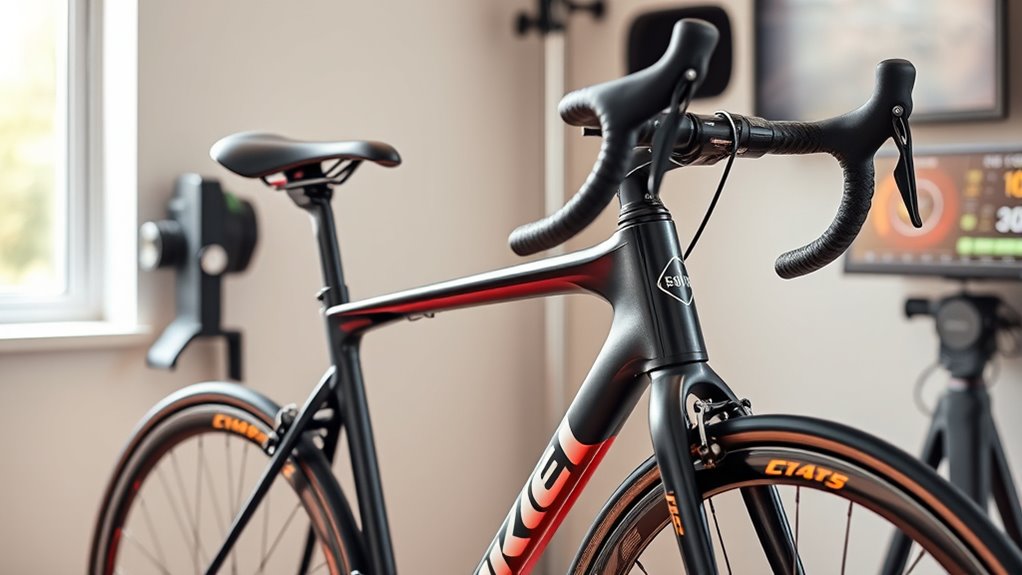
Have you ever wondered why a proper bike fit makes such a difference in your riding experience? One of the most vital aspects is getting your saddle height right. When your saddle is too high, you might feel like you’re stretching excessively at the top of your pedal stroke, which can cause knee pain and reduce your efficiency. Conversely, if your saddle is too low, you’ll end up with limited power transfer and unnecessary strain on your knees. The goal is to find that perfect saddle height where your knee has a slight bend—roughly 25 to 35 degrees—at the bottom of each pedal stroke. This position maximizes power and minimizes discomfort. To set this correctly, you can sit on your bike with one foot at the bottom of the pedal stroke, and your leg should be almost fully extended but not locked. Making small adjustments and testing your comfort and pedaling efficiency will help you dial in the ideal saddle height. Remember, a proper saddle height isn’t just about comfort; it *essentially* impacts your riding performance and injury prevention.
Next, consider handlebar reach, which directly influences your overall riding posture and control. Handlebar reach refers to how far you need to extend your arms to comfortably grip the handlebars. If the reach is too long, you’ll feel stretched out, which can lead to back, neck, and shoulder strain over time. On the other hand, if the reach is too short, you might feel cramped, reducing your ability to maneuver confidently and comfortably. To find the right handlebar reach, sit on your bike with your hands on the handlebars and your elbows slightly bent. Your back should be at a gentle angle, not overly hunched or overly upright. Adjusting the stem length or handlebar position allows you to fine-tune this reach. Ideally, your hands should rest comfortably on the bars without putting excess strain on your shoulders or wrists. Proper handlebar reach enhances control, reduces fatigue, and creates a more efficient riding position. It’s a subtle adjustment but one that makes a *considerable* difference in your overall comfort and performance.
Both saddle height and handlebar reach work together to create a balanced, comfortable riding position. When these elements are properly adjusted, you’ll notice improved efficiency, less fatigue, and a more enjoyable ride. It’s worth taking the time to experiment with small adjustments, test your comfort, and listen to your body. Bike fit isn’t a one-size-fits-all deal; it’s about customizing your setup to suit your body and riding style. A well-fitted bike feels more natural and allows you to ride longer and faster with less effort. So, don’t overlook these fundamental adjustments—they’re the foundation of a better riding experience.
Frequently Asked Questions
How Often Should I Reassess My Bike Fit?
You should reassess your bike fit whenever you notice discomfort or changes in your riding. Typically, every 3 to 6 months is a good rule, especially if you’ve recently changed your saddle height or handlebar position. Regular checks ensure your saddle height remains ideal for comfort and efficiency, while adjusting your handlebar position can prevent strain. Staying attentive to these details keeps your ride comfortable and prevents injuries.
Can a Bike Fit Improve My Cycling Performance?
A bike fit acts like a tailored suit for your ride, revealing hidden potential. By making precise ergonomic adjustments and optimizing your aerodynamics, you can elevate your cycling performance markedly. When your body aligns perfectly with your bike, you gain efficiency, reduce fatigue, and boost speed. This harmony allows you to power through climbs and sprint with ease, transforming every pedal stroke into a move closer to your best.
What Equipment Is Needed for a Professional Bike Fit?
To get a professional bike fit, you’ll need essential equipment like a bike saddle that matches your riding style and comfort needs, as well as an adjustable bike stem to fine-tune your handlebar height and reach. You might also use tools like a torque wrench, measurement devices, and fit sensors to analyze your position. This equipment helps guarantee your fit is precise, enhancing comfort and performance on the bike.
How Does Flexibility Affect Bike Fitting?
Flexibility directly impacts your bike fit by influencing muscle flexibility and joint mobility. If your muscles are tight or your joints lack mobility, you’ll struggle to find a comfortable, efficient position. You might experience pain or limited movement, which can reduce performance and increase injury risk. By improving your flexibility through stretching and mobility exercises, you allow for better positioning, comfort, and control on the bike, enhancing your overall riding experience.
Is a Custom Bike Fit Necessary for Casual Riding?
A custom bike fit isn’t strictly necessary for casual riding, but it can markedly improve your comfort and enjoyment. When you get a proper bike fit, even for casual rides, you reduce strain and prevent discomfort. If you ride regularly or for long distances, investing in a professional bike fit pays off. Otherwise, using adjustable components and paying attention to your comfort can suffice for casual cycling.
Conclusion
Now that you understand the fundamentals of bike fitting, you’re equipped to customize your ride like a tailored suit, perfectly molded to your body. Think of your bike as an extension of yourself—a harmonious dance between rider and machine. When you fine-tune your fit, every pedal stroke becomes a brushstroke on the canvas of your ride, creating a masterpiece of comfort and efficiency. Embrace these principles, and watch your cycling experience transform into a work of art.



